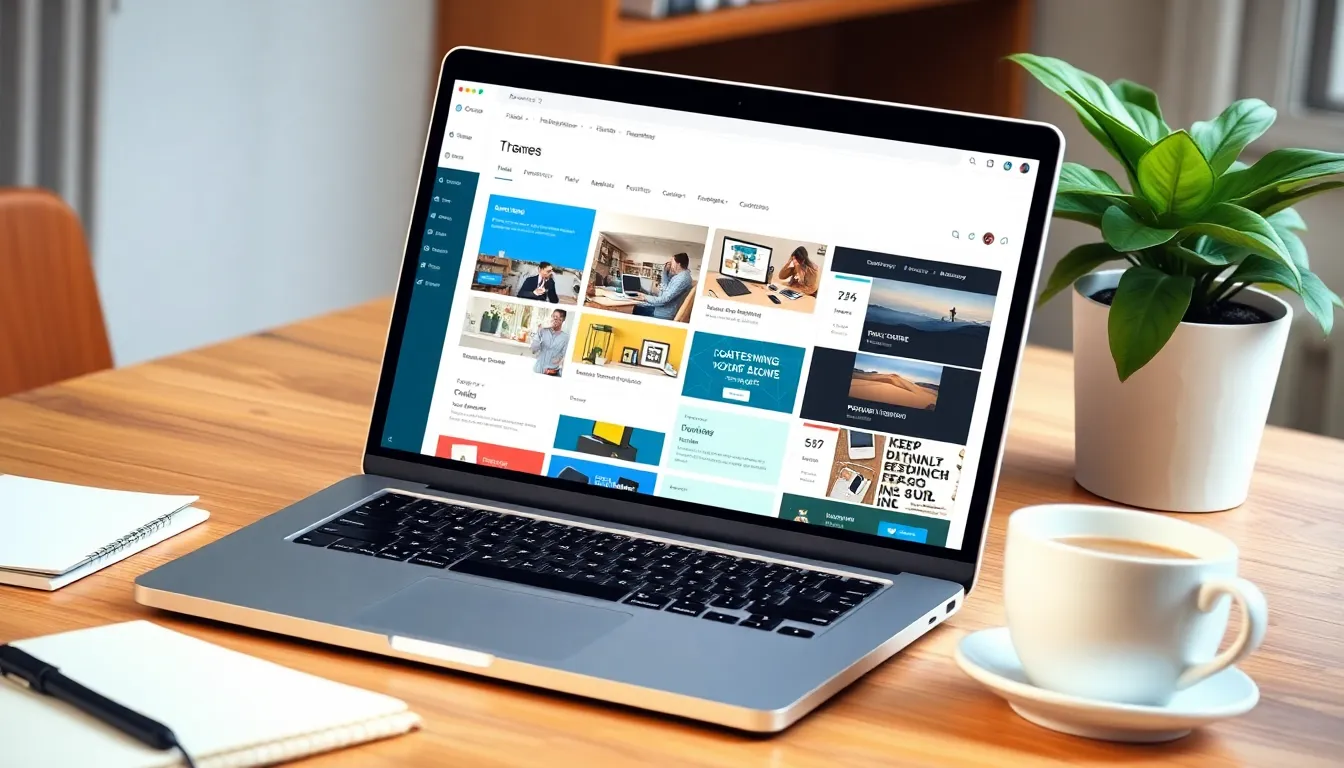In the vast ocean of the internet, a blog is like a shiny lighthouse guiding readers to your unique ideas. But what good is a lighthouse if it’s stuck in the 90s? Choosing the right WordPress theme can make or break your blogging experience. It’s not just about looking pretty; it’s about functionality, user experience, and that all-important first impression.
Imagine your blog as a cozy coffee shop. You wouldn’t want it to look like a garage sale, right? The right theme sets the mood, keeps visitors engaged, and makes them want to come back for more. From minimalist designs to vibrant layouts, there’s a theme out there that’s just waiting to showcase your voice. Let’s dive into the best WordPress themes that’ll turn your blog from drab to fab, making readers feel right at home.
Best WordPress Themes For Blogs
Selecting the right WordPress theme significantly impacts a blog’s aesthetic appeal and functionality. Various themes range from minimalist designs to feature-rich options, catering to different blogging styles. Popular examples include Astra, known for its speed and customization options, and Divi, which offers a visual builder for effortless editing.
Responsive design remains crucial in today’s mobile-centric world. Themes like Neve and GeneratePress provide excellent responsiveness, ensuring blogs look great on all devices. Consider StudioPress as well, which combines aesthetic appeal with robust SEO features.
Focus on themes that prioritize readability. A good example is Writee, specifically designed for writers, offering clean layouts and ample white space. Themes like OceanWP offer multiple demo sites, allowing bloggers to choose layouts that best fit their content.
Support and regular updates are essential for theme longevity. Themes like Hestia come with support for popular page builders, enhancing flexibility. Look for themes that offer ongoing updates to adapt to the latest WordPress standards.
Accessibility is another key aspect. Choosing themes promoting inclusive design can widen a blog’s reach. For instance, Blocksy not only focuses on speed but also enhances accessibility.
By prioritizing features like responsiveness, readability, support, and accessibility, bloggers can choose themes that enhance user experience and engagement.
Top Features to Consider

Selecting a WordPress theme for a blog involves careful consideration of several key features. Prioritizing aspects that enhance both aesthetics and functionality can significantly improve user engagement.
Customization Options
Customization options provide flexibility in design. Themes like Astra and Divi offer extensive features that allow users to tailor layouts, colors, and fonts to reflect unique branding. Users can adjust header styles, typography, and other visual elements easily. Diverse options foster creativity and help maintain a consistent look throughout the site. Regular updates from theme developers ensure that customization tools stay current with design trends.
Mobile Responsiveness
Mobile responsiveness guarantees a seamless experience across devices. Many themes, including Neve and GeneratePress, automatically adjust to different screen sizes, enhancing usability. Images and text resize appropriately, maintaining readability and functionality. Google prioritizes mobile-friendly websites in search results; thus, selecting a responsive theme boosts visibility. Prioritizing mobile responsiveness leads to higher retention and lower bounce rates.
SEO Friendliness
SEO friendliness is essential for increasing website traffic. Themes that follow best SEO practices often load quickly and feature clean code. User-friendly URLs and optimized headings enhance content discoverability. Themes like Hestia frequently provide built-in SEO tools or integrate easily with popular SEO plugins. Choosing an SEO-friendly theme improves rankings, attracting diverse audiences and expanding reach.
Best WordPress Themes for Blogs in 2023
Selecting the right WordPress theme enhances both aesthetics and functionality. Below are excellent options for bloggers in 2023.
Theme 1: Astra
Astra offers impressive speed and customization capabilities. It supports various layouts that adapt to different content types. Users appreciate the lightweight design, which improves loading times. This theme integrates smoothly with popular page builders like Elementor and Beaver Builder. Many bloggers favor Astra for its extensive library of pre-designed templates. Regular updates ensure users receive the latest features and security improvements.
Theme 2: Divi
Divi excels in visual editing with its drag-and-drop builder. Its flexibility allows bloggers to create unique layouts without coding experience. A vast array of design options supports personalization, giving every blog its distinctive look. Important elements like responsive design help maintain aesthetic consistency across devices. Divi also provides built-in split testing, empowering users to optimize their content effectively. Users benefit from a supportive community and comprehensive documentation.
Theme 3: Neve
Neve highlights mobile responsiveness and fast loading times. It features a modular design that enables users to choose only the elements they need. Bloggers find the theme’s integration with AMP beneficial for enhancing mobile performance. A wide range of starter sites caters to various niches, simplifying the setup process. Optimized for SEO, Neve aids in improving discoverability in search engines. Regular updates contribute to maintaining a secure and functional blogging environment.
How to Choose the Right Theme for Your Blog
Selecting the ideal WordPress theme requires careful consideration of various factors. Start by identifying specific needs, such as the type of content to be published. A blog focused on photography benefits from visually appealing themes like Astra, while a personal development blog might lean towards more text-driven layouts like Writee.
Next, prioritize customization options that enable unique branding. Themes like Divi and Hestia offer robust customization features, allowing users to modify colors, layouts, and fonts easily. Functionality also plays a vital role; look for themes that support essential plugins for enhanced features like social sharing and SEO optimization.
Mobile responsiveness is crucial in today’s digital landscape. Themes that adjust seamlessly to various devices, such as Neve and GeneratePress, ensure optimal user experience. Without mobile compatibility, a blog risks losing a significant portion of its audience.
Evaluate the theme’s speed, as website loading times directly impact user retention and SEO rankings. Astra excels in speed, making it a top choice for bloggers aiming to enhance performance. Regular updates and support options are essential for long-term use; check themes like Blocksy for their maintenance reputation.
Accessibility should not be overlooked. An inclusive design improves user engagement and ensures that all readers can access content. Focus on themes that adhere to accessibility standards to create a welcoming environment for all bloggers.
Understanding specific needs regarding content, prioritizing customization, ensuring mobile responsiveness, evaluating speed, and considering accessibility are key steps in selecting the right theme for a blog. Choose a theme that aligns with these factors to enhance both aesthetics and user experience.
Conclusion
Selecting the right WordPress theme can transform a blog into an engaging and inviting space. With the right balance of aesthetics and functionality bloggers can create an experience that resonates with their audience. Themes like Astra and Divi offer unique advantages that cater to various needs while ensuring mobile responsiveness and SEO optimization.
By prioritizing features such as customization options and readability bloggers can enhance user experience and keep readers coming back. The themes discussed provide a solid foundation for any blogger looking to elevate their online presence. Investing time in choosing the perfect theme is a crucial step toward building a successful blog that stands out in a crowded digital landscape.

